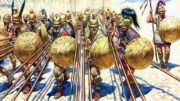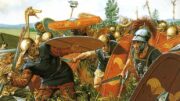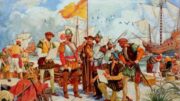Introduction
History is witness to the triumph of the ancient Roman army, as evidenced by the Roman empire in its apical scope – which held sway over a major chunk of the known world, ranging from Spain to Syria (and Iraq), and from North African coasts and Egypt to most of Britain. Suffice it to say, this ancient military was known for its sheer discipline, incredible organizational depth, and ability to adapt.
Some of these qualities were demonstrated through logistics during the Second Punic War, where the Romans ultimately emerged victorious, in spite of (possibly) losing one-tenth to one-twentieth of their male population in a single battle (at Cannae). And complementing their unflinching capacity to bounce back from disastrous situations, was the evolution of the Roman military over the centuries.
To that end, a plethora of Roman military developments were actually ‘instigated’ by their foes, and as such many of the successes of the ancient Roman military system can be attributed to their inherent capacity to simply ‘react’.
Contents
Evolution of Tactics of the Roman Army –
This fascinating graphical video concocted by YouTuber Historia Civilis aptly showcases the ‘reactionary’ evolution of Roman battle tactics. And while the content treads a simplistic (though nifty) overview, we can get the core idea behind the Roman military system and how its adaptability set it apart from some of the other militaries of the ancient world.
The Early Roman Levy

While the video doesn’t really cover the scope of the Romans during their initial days, the earliest Roman army equipment’s archaeological evidence ranges far back to the 9th century BC, mostly from the warrior tombs on Capitoline Hill. As for the literary evidence, they mention how the earliest Roman armies were recruited from the three main ‘tribes’ of Rome.
This shouldn’t come as too much of a shock (for those who are used to reading about the ‘civilized’ nature of Rome) since the settlement of Rome itself started out as a backwater which was inhabited by cattle rustlers who made their camps and rudimentary dwellings among the hills and the swamplands.
As for the evolutionary part, the transition of the Roman army from ‘tribal’ warriors to citizen militia was achieved in part due to Roman society and its intrinsic representation (with voting rights) in the Roman assembly.
To that end, the early Romans almost entirely depended on their citizen militia for the protection and extension of the burgeoning faction’s borders. These militiamen were simply raised as levy or legio – which in turn gives way to the term ‘legion’. In essence, the so-called legions of early Rome were ‘poor’ predecessors to the uniformly-equipped and disciplined soldiers of the ensuing centuries (which we have discussed later).
The Roman Phalanx

The video starts off with what can be termed the first solid formation of the Roman army (when Rome was still a city-state kingdom). And quite unsurprisingly, the Roman military system of this time was inspired by its more-advanced neighbor (and enemy) – the Etruscans.
In fact, the mass formation of hoplites fighting with their shield and spear – known as a phalanx, was already adopted by the Greeks by 675 BC and reached the Italy-based Etruscans by the early 7th century BC. The Romans, in turn, were influenced by their Etruscan foes and thus managed to enact many of the rigid Greek-inspired formations along with arms in real-time battle scenarios.
Many ancient authors conform to this Roman army’s adoption of ‘foreign’ tactics. For example, Diodorus Siculus (In his The Library of History) mentions how the Romans ditched their light rectangular shields and endorsed the heavier bronze shields of the Etruscans.
This military replication, in turn, allowed the Romans to triumph over the Etruscans. Anon (in his Ineditum Vaticanum) also supports this view by saying how the Etruscans were given a taste of their own medicine when the Roman army embraced the very same tight hoplite formations to counter its enemies.
As per historical tradition, the adoption of the hoplite tactics was fueled by the sweeping military reforms undertaken by the penultimate Roman ruler Servius Tullius, who probably ruled in the 6th century BC. He made a departure from the ‘tribal’ institutions of curia and gentes, and instead divided the military based on the individual soldier’s possession of the property. In that regard, the Roman army and its mirroring peace-time society were segregated into classes (classis).
According to Livy, there were six such classes – all based on their possession of wealth (that was defined by asses or small copper coins). The first three classes fought as the traditional hoplites, armed with spears and shields – although the armaments decreased based on their economic statuses.
The fourth class was only armed with spears and javelins, while the fifth class was scantily armed with slings. Finally, the sixth (and poorest) class was totally exempt from military service. This system once again alludes to how the early Roman army was formed on truly nationalistic values. Simply put, these men left their homes and went to war to protect (or increase) their own lands and wealth, as opposed to opting for just a military ‘career’.
The Roman Maniple
But the greatest strength of the Roman army had always been its adaptability and capability to evolve. Like we mentioned before how the early Romans from their kingdom era adopted the hoplite tactics of their foes and defeated them in turn.
However, by the time of the First Samnite War (around 343 BC), the Roman army seemed to have endorsed newer formations that were more flexible in nature. This change in battle-oriented stratagem was probably in response to the hardy Samnite armies – and as a result, the maniple formations came into existence (instead of the earlier rigid phalanx).
The very term manipulus means ‘a handful’, and thus its early standard incorporated a pole with a handful of hay placed around it. According to most literary pieces of evidence, the Roman army was now divided up into three separate battle lines, with first-line, comprising the young hastati in ten maniples (each of 120 men); the second line comprising the hardened principes in ten maniples; and the third and last line consisting of the veteran triarii in ten maniples – who probably fought as heavy hoplites (but their maniples had only 60 men).
Additionally, these battle lines were also possibly screened by the light-armed velites, who mostly belonged to the poorer class of Roman civilians. Suffice it to say, a maniple was a far more flexible formation than the ‘solid’ yet (occasionally) unwieldy phalanx. More importantly, these formations, collectively called the triplex acies, allowed for a battlefield system of reserves to be deployed for better tactical advantage.
For example, when the front-lining hastati was drained of his strength during the heat of the battle, he could fall back upon the reserve lines of the elite triarii. The well-armored veterans were then deployed forward in a cyclic manner – thus resulting in a fresh batch of troops countering the exhausted (and usually less organized) enemy. This simple yet effective tactic changed the outcome of many a smaller battle in the 4th century BC – as represented by the above video (reconstructed by Invictus, in the Rome 2 game engine).
The Roman Cohort

As the Roman realm continued to expand at a rapid rate, especially during and after the conclusion of the Second Punic War, the Romans encountered larger armies of the more organized military powers of contemporary times. By the 2nd century BC, the maniples were simply not ‘big’ enough to be deployed on a mass scale in battles.
So again, as a reactionary measure, the Romans (gradually) moved away from a pseudo-class-based system, to induct a collective solution for their armies. The result was the cohort – a flexible group of around 480 men who were armed and armored in a similar fashion. Ten such cohorts made a legion, and thus the later Roman soldiers are simply known as the legionaries, as opposed to individualistic categorization like hastati and triarii.
For all intents and purposes, the Roman legionary was a professional soldier of ancient times – recruited (and sometimes conscripted) from different parts of the Roman Republic (and later Empire). As befitting a professional soldier, the green recruits who were successfully enlisted as legionaries had to go through a stringent training period of 4 months.
During this training regimen, each soldier was given the unenviable task of marching 29 km (18 miles) in five hours with regular steps, and then 35 km (21.7 miles) in five hours with faster steps – all the while carrying a backpack that weighed 45 lbs (20.5 kg).
This weight was intentionally allotted for increasing the endurance level of a legionary and thus added to the overall weight of the panoply worn by the soldiers in their full gear (the weight of the Lorica segmentata armor alone might have gone beyond 20 lbs).
As expected, the ‘slowpokes’ were severely beaten by centurions and officers with their staffs. Interestingly enough, many of the similar ‘regimens’ are preserved through our modern military culture – with elite forces of some countries trained via such rigorous boot camp methods.
The Organization of the Roman Army –
The ancient Roman army was known for its sheer discipline and incredible organizational depth. Pertaining to the latter ‘quality’, an animated short video by Blair Harrower aptly demonstrates how the Romans organized their army down to the last details when it came to troop types, corresponding officers, and their formations, thus alluding to an impressive tactical scope that was matched by very few ancient armies.
Now it should be noted that the animation showcases the scope of post-Marian reforms – a military system overhaul that only took place after 107 BC (thus corresponding to the late Roman Republic and the subsequent Roman Empire).
Length of Service

Now while the video does provide some solid, unwavering numbers when it came to Roman legionaries, in actual scenarios the situations faced by the Roman army were often more chaotic. During the latter part of the 1st century BC, Augustus followed the guidelines of the preceding centuries and officially formalized the length of service of a legionary to 16 years (in 13 BC). But it should be noted that even after 16 years of service, he was expected to join the vexillum veteranorum or unit of veterans for four more years.
However, by 6 AD, the initial length of service was increased to 20 years, and it was complemented by the praemia militare (or discharge bonus), a lump sum that was increased to 12,000 sesterces (or 3,000 denarii). And by the middle of the 1st century AD, the service was further extended to 25 years.
Now beyond official service lengths, the protocols were rarely followed in times marked by wars. This resulted in retaining the legionaries well beyond their service periods, with some men fighting under their legions for over three to four decades. Suffice it to say, such chaotic measures frequently resulted in mutinies.
As for pay, other than the lump sum of praemia militare, a basic legionary was paid 900 sesterces per year (paid in three installments). This pay scale remained the same until at least 80 AD, in spite of presumed inflation. However, the pay differed for the various units in a legion, with under-officers and specialists being paid one-and-a-half or twice the basic pay grade.
And furthermore, this pay figure was only a nominal value from which various deductions were made in accordance with the goods (like food, equipment, attires, and even burial fees) consumed by the legionary. Still, there were cases when the legionary was paid less than he deserved, and sometimes the ‘swindling’ measures were initiated by giving the soldiers worthless parcels of land instead of the praemia militare.
Bonding Beyond Numbers

The video clearly mentions how a contubernium was the smallest division in a Roman army. Now beyond discipline and training, one of the crucial reasons for the effectiveness of a legionary was directly related to his sense of fraternity within a century (made of 80 men). So on a deeper level, a century (centuria) was further divided into ten contubernium (a ‘tent group’, each consisting of eight members).
Such classifications basically led to a behavioral aspect of comradeship among the tent group who fought, dined, and rested together in their military careers spanning over decades. This sense of identification often translated to high morale and protectiveness on the part of the legionaries when fighting in an actual battleground.
Interestingly, the contubernium was not just limited to the bonding exercises. The Roman army also pushed forth the tent group as a mess ‘team’. These grouped soldiers were expected to cook their own meals and eat them together (while the cost of food was deducted from their salaries). Simply put, the absence of mess halls and catering services rather solidified the bond between the legionaries who had to depend on each other even for peaceful meals.
Other Specialized Units

As we mentioned before, a legionary was only considered a veteran after he had served for 16 years in the army. In the 1st century AD, even after such a long period of service, the soldier was not expected to ‘retire’ from his legion. Instead, the veteran was reinstated to a special unit of vexillum veteranorum for four more years of service.
Typically consisting of 500 to 600 men, the Roman army unit had its own administrative branch with different officers. It was however attached to the original legion, but at times was deployed independently. The latter case is evident from their separate garrison at the town of Thala, with this particular vexillum veteranorum being derived from Legio III Augusta in 20 AD. Unsurprisingly, the veterans with their years of experience were highly successful against the onslaught of Tacfarinas and his Numidian forces.
Other than vexillum veteranorum, there were also slaves (or calones) that could be attached to a legion. Although, unlike the veterans, they were governed as a part of the legion, with 120 men attached to each cohort of 480 soldiers. So basically, a single legion (generally comprising ten cohorts) could be accompanied by around 1,200 slaves; and these men were trained for specific tasks. During times of emergency, they were even armed with weapons to defend their camps.
And finally, the soldiers who truly made a Roman military unit self-sufficient were the immunes, a group of highly trained specialists attached to each legion. Ranging from doctors, and engineers to architects, these men were exempt from the hard labor duties of the rank-and-file soldiers, while also earning more than them.
The Command Structure of the Roman Army –
We already talked about the fascinating organization of the Roman army. However, the strength of the Roman legion was also complemented by its incredibly deep yet sufficiently straightforward command structure. In other words, the hierarchical system of command was tailored to suit both ways, with overlapping representations that mirrored the interests of the senate, the aristocracy, and most importantly – the rank-and-file soldiers (legionaries).
In essence, it was a collective scope of leadership that fueled the tactical maneuvers (and even strategic deployment) of a legion – and this complex ambit is presented in a comprehensible manner by Historia Civilis’ amazing short animation on the command structure of the Roman legion.
Note* – The animation showcases the scope of post-Marian reforms – a military system overhaul that only took place after 107 BC (thus corresponding to the late Roman Republic and the subsequent Roman Empire).
The Vexillationes

While Roman legions fighting at their full capacity was a regular occurrence during the early 2nd century AD, by the middle of the 3rd century the conflicts faced by the Roman empire (and the changing emperors) were pretty volatile from both the geographical and logistical scope. And so it was uncommon and rather impractical for the entire legion to leave its provincial base to fight a ‘distant’ war on the shifting frontiers of the 3rd century AD.
As a solution, the Roman military commanders sanctioned the use of vexillationes – detachments from individual legions that could be easily transferred without compromising the core strength of a legion (which was needed for fortifying and policing its ‘native’ province).
These mobile combat ‘divisions’, comprising one or two cohorts, were usually tasked with handling the smaller enemy forces while being also used for garrisoning duties along with strategic points like roads, bridges, and forts. And on rare occasions when the Romans were faced with a large number of opposing troops, many of these different vexillationes were combined to form a bigger field army.
The Comitatus

The later Roman Empire and its volatile political scope also brought forth newer Roman units separate from the Roman Legion. For example, Emperor Gallienus (who ruled alone from 260 to 268 AD) created his own mobile field army consisting of special detachments from the praetorians, Legio II Parthica, and other guard units.
Hailed as the comitatus (retinue), this central reserve force functioned under the emperor’s direct command, thus hinting at the ambit of insecurities faced by the Roman rulers and elites during the ‘Crisis of the Third Century’. Interestingly enough, many of ‘extra’ equites (cavalry) that were assigned to each conventional legion, were also inducted as the elite promoti cavalry in the already opulent (and the militarily capable) scope of the comitatus.
Featured Image: Artwork by Justin Juta




Be the first to comment on "The Roman Army: Tactics, Organization, and Command Structure"